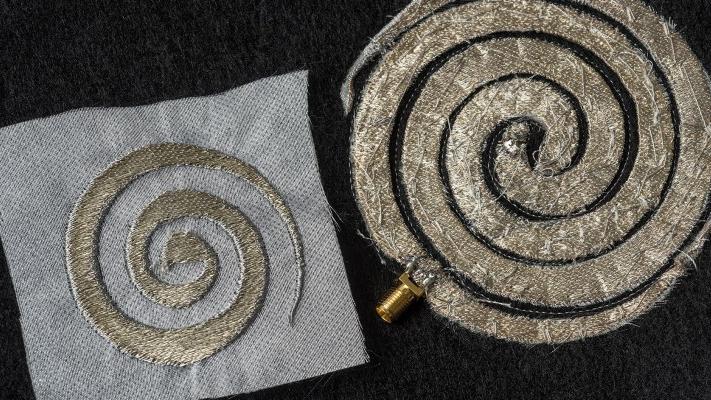conductivethread
Latest

Conductive thread stores data in clothes without built-in tech
New technology may soon enable you to get into your home or office with nothing more than your coat, wristband or tie. Scientists at the University of Washington have found a way to create smart fabric, using only conductive thread with no other added electronics.

Stitch circuitry into your shirt for a better cell signal
Wearables are getting slimmer, but they're still oblong lumps worn over normal outfits. That's not enough for some tinkerers who are trying to make clothes themselves part of the computing (see: Drum Pants). Now, Ohio State University researchers are stitching conductive threads into clothing with precision that rivals printed circuit boards.

Newer Technology's NuTouch Gloves are a warm way to use your mobile devices
Going outside to get some exercise doesn't necessarily mean I leave my techie toys at home. In fact, I take my iPhone 4S with me everywhere so that I can keep track of how many steps I'm taking, the distance I'm walking, and so on. In the winter, I need a way to keep my hands warm and still be able to use the iPhone without taking the gloves off, and that's where the NuTouch Gloves (US$19.99) from Newer Technology might come in handy (no pun intended). These gloves are made of a dark gray cotton/Spandex mix that gives them a light feel and a lot of flexibility. Since cotton isn't conductive itself, the gloves have a conductive fiber woven into all 10 fingertips so that you can continue to use multi-touch gestures even while wearing them. NuTouch Gloves come in four sizes, so you can get a glove that fits perfectly on your hands. The gloves are warm enough for some brisk days, but won't work on their own in extremely cold weather. That's fine -- they're thin enough that they'll work as a liner inside full cold weather gloves. How do they work? Perfectly. My previous "iPhone gloves" were made by Freehands, and feature folding fingertips that reveal your thumb and forefinger when you need to touch the screen. The only problem is that this exposes your fingers to the cold during those moments when you're using the device. Not so with the NuTouch gloves, which keep those fingertips and hands warm even when you're dialing your iPhone in the freezing cold. There are other gloves of this type: TUAW blogger Michael Grothaus reviewed a similar pair of gloves from Mujjo a few weeks ago and was quite happy with them. However, the Mujjo gloves cost about $32 and don't appear to be much different from the much less expensive NuTouch Gloves. I had only one complaint about the NuTouch Gloves -- the pair I was sent for review had a rip atop the right thumb. Despite that cosmetic flaw, the gloves worked wonderfully in testing on the iPhone 4S. I've even worn them on cold days in my house, since they work great with the Magic Trackpad. I'm giving the NuTouch Gloves a warm two thumbs-up!

Capacitive touch brush stylus made from conductive thread
Artist Margarita Benitez really wanted a Nomad Brush for her iPad but didn't have the cash for the actual thing, so she did the next best: she made one herself. Using an old brush handle and some conductive thread, she was able to assemble a working brush, and says it works better than expected. Her entry at Instructables has all of the instructions if you want to give one a shot yourself. I would say that if I tried one myself, I'd probably go with a different brush handle -- hers is a little thin for my tastes, though each artist probably has their own preference about what kind of brush you'd need (and it might just depend on the project as well). She also had to use a metal holder for the brush head and holds the brush with her fingers touching it, in order to send the capacitive charge down into the screen itself. I bet there's a way to improve on that, though, either by using a metal brush handle completely, or by running a strip of metal up and down the side of the brush. Either way, Benitez' result looks great. If you do jump in and put one together, be sure to send pictures to us on the tipline so we can see yours in action! [via Make]

With 'Ping' clothing, status updates literally tap you on the shoulder
Arduino-powered clothing is nothing new; we've seen CO2-detecting dresses, compass belts and inbox-checking T-shirts all within the last six months. But this Ping social networking garment concept is not quite the same thing. Where those were DIY projects with a single-function, Ping is the brainchild of a professional UI designer... and the fabric itself is a social network UI that registers your movements as attempts to communicate. Woven with flexible sensors and conductive threads connected to an Arduino Lilypad and Xbee, clothing made from the fabric can detect when you lift a hood or tie a ribbon and wirelessly send Facebook status updates accordingly -- or tap you on the shoulder in a number of different rhythms so you know not only when, but who might be trying to get in touch. Designer Jennifer Darmour imagines a future in which clothing offers full-body 3D gesture recognition and senses our environment. When we can reliably use it to control our computers, we hope she'll get in touch.

DIY touchscreen gloves are as simple as a few stitches
Sure you could buy any number of capacitive touchscreen-friendly gloves available these days (like the Dots iPhone gloves we tried on last winter) -- but what if you're looking for something a little warmer or more stylish? Then you might want consider a DIY pair, which turn out to be far easier to make then you might think. As Instructables member Grathio has helpfully laid out, all you need is the pair of gloves of your choice, a needle, and a magical material known as conductive thread (used in all sorts of wearable electronics), which you simply sew into as many fingertips as you like. Ready to get started? All the details you need are at the link below.



